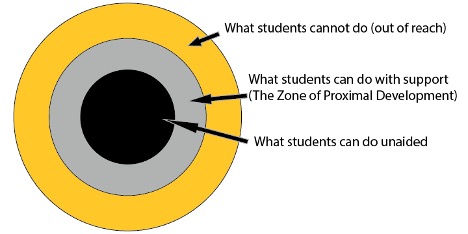Instructional Scaffolding
Table of Contents
Using new information and skills does not come naturally. Think about the process of a child learning to walk, or when you learned to ride a bicycle, or even drive a car. In real life, people don’t simply read an article and then jump on a bike or turn the ignition and go. Even if they’ve watched others do it for years and understand the technical steps (which pedals make the car go and stop, where the turn signal is, or how to put the vehicle in drive), rarely do people read a manual and jump in the driver’s seat without extensive practice and training from someone in the passenger seat. And most kids don’t jump on a bike and take off without first having an adult’s hand holding the seat until the child is ready to let go (or the adult can’t keep up!).
The Russian child-psychologist Lev Vygotsky proposed the concept called the Zone of Proximal Development (ZPD). He suggested that between what a learner simply cannot do and what a learner can do unaided lays a range of skills that they can do with targeted assistance. Some have referred to this as a “‘sweet spot’ where instruction is most beneficial for each student—just beyond their current level of independent capability.” Once one understands the concept, the goal is to find what students can and cannot do, then develop the “support structure” to help them develop the skills they need.

Instructional Scaffolding refers to the supports provided by educators to help students move through the ZPD. As students develop the proximal skills, the supports (like training wheels) are gradually removed until what the students could not do before is now mastered. Another way to understand the concept is that, at the beginning of the learning process, the teacher provides more of the support and responsibility for the demonstration of the knowledge and skills. As time passes in the learning experience, the teacher’s support fades and responsibility for demonstrating the knowledge and skills passes more to the learner (van de Pol, et al. 2010).
The first step in scaffolding a course or an assignment is to focus on the objectives. Well-written objectives should describe exactly what knowledge and skills students should be able to demonstrate. If your objectives don’t make clear what students will be able to do, then you may need to rework them.
Next, review the assessment(s) you are using to measure the objectives and answer the following questions:
- Does the assessment accurately measure the objectives?
- Are there elements to the assessment which are unrelated to the objectives?
- Are there elements of the objective which are not addressed by the assessment?
If not, you may need to tweak the assessment.
Based on your analysis of your objective(s) and assessment(s), you will need to determine what prerequisite knowledge and skills the students should reasonably be bringing with them. Consider what experiences they may have had throughout their education as well as curricular prerequisites. Remember, not all students will bring the same knowledge and skills, so focus on what is reasonable and plan to adjust accordingly based on what you learned about your students during your course.
Finally, review your instructional material to gauge whether it is providing the learning experiences necessary for them to master the assessment. What kinds of smaller assignments, learning activities, or experiences can you introduce to allow students to practice and receive structured feedback along the way before they get to the large summative assessment?
Scaffolding may be provided through many means such as giving feedback or hints along the way, supplying exact instructions (the how), explaining processes, modeling the skills for imitation, or questioning the students to prompt the correct answers (van de Pol, et al. 2010). Check our Resources for scaffolding examples.
Supplemental Material: scaffolding examples from Vicki Caruana, Ph.D.
Scaffolding Learning in the Online Classroom from Wiley Center for Teaching and Learning
Examples of scaffolding activities from University at Buffalo Center for Educational Innovation
Raising the Quality of Discussion by Scaffolding Students’ Reading [PDF] by Jane West, Mercer University
-
References
Caruana, V. (2012, October 15) Scaffolding Student Learning: Tips for Getting Started. Retrieved from https://www.facultyfocus.com/articles/course-design-ideas/scaffolding-student-learning-tips-for-getting-started/
Vygotskiĭ, L. S., Cole, M., Stein, S., & Sekula, A. (1978). Mind in society: The development of higher psychological processes. Cambridge, MA: Harvard University Press.
Knestrick, J. (2012, November 27). The Zone of Proximal Development (ZPD) and Why It Matters for Early Childhood Learning. Retrieved from https://www.nwea.org/blog/2012/the-zone-of-proximal-development-zpd-and-why-it-matters-for-early-childhood-learning/
Hogan, K., & Pressley, M. (1998). Scaffolding student learning: Instructional approaches and issues. Cambridge, MA: Brookline Books.
van de Pol, J., Volman, M. & Beishuizen, J. Scaffolding in Teacher–Student Interaction: A Decade of Research. Educ Psychol Rev 22, 271–296 (2010). https://doi.org/10.1007/s10648-010-9127-6











